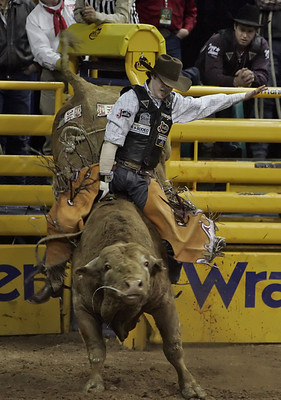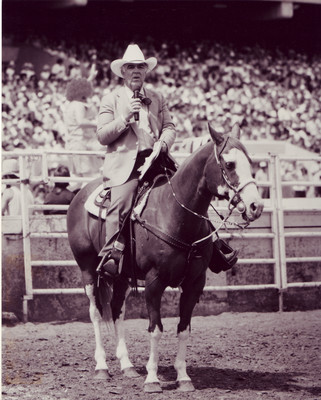Injuries are mere nuisance to riders



Bull rider Kanin Asay’s encounter with a rodeo bull five months ago left him with a ruptured spleen, torn right ear and a broken rib.
He had his ear sewed back on and spleen removed after his rodeo wreck in Oregon.
Fellow bull rider Wesley Silcox two months ago had his right leg fractured in two places above the ankle when a 1,600-pound bull stepped on him. A rod was inserted and attached with six screws.
Doctors told him to be more careful.
Not only are Asay and Silcox competing in the National Finals Rodeo, but both won money in Sunday’s fourth go-round before 17,149 at the Thomas & Mack Center.
Asay, of Powell, Wyo., took third and Silcox, the reigning world champion from Payson, Utah, tied for fourth.
"We’ve gotta compete," Silcox said. "We don’t get paid for being hurt."
For more evidence, consider Arizona bull rider Cody Hancock, who was second Sunday.
After three-quarters of his right ear was severed by a bull’s hoof in 2005, Hancock came back to ride the next night in Clovis, Calif. He won the go-round and event titles.
"You don’t need an ear to ride a bull," he said.
Bull riding remains the most dangerous event in rodeo, though all participants wear protective vests and a few wear helmets with face guards.
The safety movement began when former world champion Lane Frost died in 1989 after being gored in the back by a bull after completing a ride in Cheyenne, Wyo.
The only human fatality in the Finals’ 24-year history in Las Vegas occurred in 1994 when bull rider Brent Thurman died a few days after a bull stepped on him.
Asay believes a contributing factor to his injuries this year was first getting knocked in the head by the bull before he was bucked to the ground. He began wearing a helmet when he returned to competition.
Silcox still opts for a cowboy hat instead of any head or facial protection, which explains the dark bruise he sustained below his left eye when a bull hoof caught him in the face a couple of nights ago.
"I get myself pretty healthy before I get back on. It helps," Silcox said. "This is the NFR; I wasn’t going to miss it."
While sitting aboard Banana Daquiri in the chute Sunday, the bull moved around and smashed Silcox’s semi-healed leg against a metal railing.
"It didn’t affect my riding, but he pulled on my arm a little and that’s the sorest part of my body," Silcox said.
Wyoming’s Bobby Welsh, the winner of Sunday’s go-round with an 88-point ride on Corey & Horst’s North Star, doesn’t wear a helmet, either.
Welsh began his fourth Finals ranked 11th and has climbed to fourth by being among only two NFR contestants to win two of four go-rounds. He has won $33,533, including $16,766 on Sunday to increase his season earnings to $149,348.
"I ride on faith and travel on faith," said Welsh, a 24-year-old father of three. "It’s all God. Fear is the attack of the enemy. God said don’t be scared and I’m not."
Welsh said his only rodeo injury was a concussion about a year ago, and he has never broken a bone — in his life.
"Fear always tries to rise up and get you," he said.
Contact reporter Jeff Wolf at jwolf@reviewjournal.com or 702-383-0247.
NFR MOMENTS IN HISTORY Members of the rodeo community helped select the 10 most memorable events of the past 49 National Finals Rodeos. The countdown to No. 1 continues today. No. 6 1967 Oklahoma City It was the first year that the late Clem McSpadden managed the NFR in Oklahoma City, a position he held through 1984, after which it moved to Las Vegas. That also was the year bull rider Freckles Brown — just shy of his 47th birthday — became the first to successfully ride the famed Tornado after 220 men had failed. Brown later was the first to ride Tex M and went on to win the Finals as Larry Mahan won the world title. For more details on the 1967 NFR, read Rodeo Blog.











